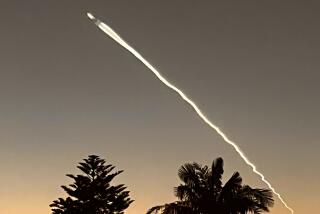Deployed Satellite Working Well, NASA Says
- Share via
HOUSTON — A $120-million communications satellite lofted into space by the crew of the shuttle Atlantis was performing well as ground controllers began tests that will last two months, NASA officials said Saturday.
The two-ton Tracking and Data Relay Satellite, or TDRS, successfully unfurled its solar panels and gold-plated antennas and was responding to all commands, flight director Phil Engelauf said at a Johnson Space Center briefing.
“The TDRS folks are thrilled to death. Everything seems to be going just perfectly for them,” he said.
The astronauts also used a special instrument to measure the Earth’s ozone layer--for information that will be used to calibrate other ozone-measuring devices--and sent back television shots of the giant, swirling clouds of Hurricane Fefa, now churning off the coast of Baja California.
TDRS, the fourth such satellite deployed by the National Aeronautics and Space Administration, was catapulted by a twin-engine rocket 22,300 miles above the Pacific Ocean to a point above the Equator.
The satellite will take over the tasks of a balky TDRS that was deployed in 1988, which controllers shuffled a few thousand miles east to a spot over South America to be used as a spare.
The constellation of satellites provides the space agency nearly constant communication with shuttles, unmanned space probes and the troubled Hubble Space Telescope as they circle the Earth.
The deployment of TDRS was the main objective of what will now become, barring unforeseen developments, a routine shuttle mission, officials said.
The five astronauts will spend their days until next Sunday’s scheduled landing performing a series of medical and technical experiments, a number of which have been done on earlier spaceflights.
The astronauts on Saturday began testing a device that scientists hope will prevent heat buildup in the proposed space station Freedom. Two crew members also started a daily regimen of running on a treadmill for 30 minutes to help determine the effects of weightlessness on the body.
The only failure of note occurred when mission specialist Shannon Lucid tried to activate biomedical processing tests by injecting nutrients into test tubes. The syringes did not function properly on several of the tests, causing the materials in the tubes to leak out.
According to experiment manager Kyle Fairchild, small amounts of bacteria and white blood cells escaped from the tubes. The amounts were small enough to be contained either by covering them with plastic bags or simply wiping them up, he said.
“These materials are completely nontoxic so they are no danger to the crew,” Fairchild said.
More to Read
Sign up for Essential California
The most important California stories and recommendations in your inbox every morning.
You may occasionally receive promotional content from the Los Angeles Times.













